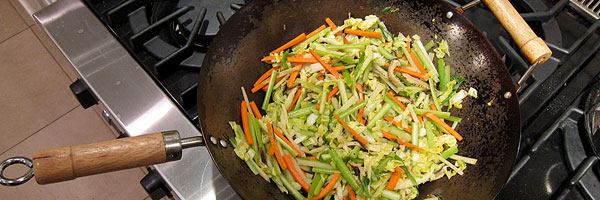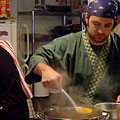Wok Strategy
 | |
| It's a beautiful jet black under the veg.. really! | Dominic Armato |
It's been said that trying to stir-fry on a consumer range is an exercise in futility. Yeah, you can cook in a wok on a stovetop. But even if you're blessed with a Five Star range, those 21,000 BTUs have nothing on wok burners, which routinely run in the neighborhood of 100,000 BTUs. Serious wok cookery requires serious heat.
I'm in the camp that believes stir-frying at home isn't a pointless endeavor. But ensuring that you're actually stir-frying and not steaming requires some coping strategies. Things like letting your vegetables air-dry, letting your meat come to room temperature, not cooking large batches of anything, giving your wok time to preheat, etc. all aid in eliminating steam and keeping your temperature as high as possible. It's still nothing like working a professional wok burner, but if you're smart about it, I think it conveys enough of a benefit to make stir-frying at home a meaningful pursuit.
All of which is why I was delighted the other night to figure out a little trick that I think was rather helpful. One of the biggest challenges is that you usually cook your meat first, and dumping a big pile of meat into a wok makes its temperature plummet, the burner can't catch up, and by the time you get to vegetables they're slowly steaming from the pool of liquid in the bottom of the wok. So I always pull my meat out of the fridge and let it warm up a bit before cooking, to minimize the impact it has on the temperature of the wok. Thing is, the other night, I forgot to do that. And with dinnertime just minutes away, I had an ice cold bowl of meat. So I panicked, turned the oven on low, and tossed the bowl of meat in to warm up for a few minutes before I stir-fried it.
The result was an unusually good home stir-fry.
Why not, right? If letting the meat lose some of its chill by pulling it out of the fridge 20 minutes before you stir-fry helps keep your wok temperature high, why wouldn't letting the meat get slightly warm in a very low oven help even more? Of course there's a limit here. You warm it too much and you're actually starting to cook it, and I don't imagine that would work out well. But I think I caught it at just the right time... when it was starting to get slightly warm but before it started cooking, which allowed my wok to stay even hotter than usual. A little experimentation is clearly in order, but you'd better believe I'm trying this one again.


Interesting post. I have a *very* regular stove. The best I've been able to figure out with my setup is to use a cast iron skillet, get it literally smoking hot, and cook in small batches. Obviously the cast iron helps with heat retention.
I actually like to start with the meat or other protein very cold. I feel that way it gives it a chance to sear the outside without overcooking. I cook the meat separate from the veg, typically doing veg first as I find it easier to hold the veg after cooking than the meat.
Overall, works pretty well if I'm cooking for 2-3. Very hard to scale up beyond that.
Posted by: chrish | December 15, 2011 at 09:16 AM
Chrish... Like I say, further experimentation is definitely called for.
Overcooking definitely was not an issue. In fact, the meat seared far more easily than normal. I had a nice brown sear on the meat (matchstick pork loin) in maybe 10-15 seconds. It actually surprised me how quickly it seared up. It's important to note, in case it wasn't clear, that the meat wasn't at all cooked before going into the wok. It was still completely raw. Just a little warmer than room temp, I think. Clearly, this calls for the Thermapen.
I find the opposite with meat/veg order. I find that veg doesn't hold as well, and I let carryover work for me. I always do meat first, give it a sear and lose the outside color, then transfer it to a plate and carryover takes it the rest of the way while I do the veg. Then when the veg is just shy of ready, I pitch the meat back in and let everything go for another 30 seconds or so.
Totally agreed on volume, though. I can't imagine any way to stir-fry at home for more than 2-3 people.
Posted by: Skillet Doux | December 15, 2011 at 09:31 AM
Hmmm.... I wonder if a bread machine would work, on the proofing setting. I prefer to slice my meat while semi-frozen, shortly before cooking, so this is a pretty neat trick to me.
I also do the meat in the first batch, but more to get some fond in the pan for the veg than anything else.
By the way, that looks like some very nice seasoning on that wok. I actually don't even bother with a wok myself - I use a flat 12" cast iron frying pan, but I'm seldom cooking for more than two.
Posted by: Independent George | December 15, 2011 at 09:53 AM
George... Oy... it's dark all the way to the top, but it's a weird mottled pattern. When I seasoned this one, I tried the oven method, which actually worked really well! But I think I didn't scrub it enough beforehand, and some of the protective coating -- whatever they use -- was still on there, so maybe 6-9 months into use, the seasoning all started flaking off. I decided to just push through rather than trying to strip and reseason it, and the bottom half is now black and beautiful and smooth and very nonstick, but the top half is kind of a rough mess. If you look closely you can see it.
If you guys try the oven thing, report back. Always best to compare data :-)
Posted by: Skillet Doux | December 15, 2011 at 09:57 AM
I'm going to try two alternates: my rice cooker, and the toaster oven.
Both are nice, low-temperature heating elements, but considerably smaller than the oven. The thing that makes me wonder about the oven is that because of the large space, the meat might dehydrate due to convection.
Dom, my pan has a ring right around the corner where the sides meet the bottom. I stripped the factory seasoning on the bottom, but use it enough that it's now beautifully smooth & black. The sides get so little action that the factory finish is still there, but there's a weird little border area where the two meet. Everything sticks to that zone.
Posted by: Independent George | December 15, 2011 at 10:03 AM
Interesting. I may experiment further. I probably haven't changed what I've been doing for 10+ years, so while I remember why I believe I settled on my approach, I can't remember the details of what didn't work as well with other approaches.
Will maybe experiment with meat/veg order. I guess my rationale for the order I use is twofold. First, for many "meats", beef as well as seafood, I feel the like tolerance zone of doneness is much narrower than for the veg, so I find it easier to control if I'm doing it all in one go. But I can see how this can be dealt with doing meat first if your sense of when to pull it off is good. But second, I like to maximize the opportunity-to-sear time and taking it off stove and then reintroducing it even if briefly seems to work against that.
But, none of this has been subjected to double blind cooks illustrated style A/B testing. And, as I said, what testing I did was a long time ago, so it may mostly be my rationalization at this time.
Posted by: chrish | December 15, 2011 at 10:18 AM
Pretty interesting to read this discussion. I have always been disappointed in my stir fries, and now I'm starting to wonder if it was a heat/steam issue. Is the rule of thumb to cook the food as hot and as fast as possible?
Posted by: KinderJ | December 15, 2011 at 01:50 PM
To take a MG/Modernist take on this, isn't this a bit like the concepts behind sous vide? The standard sous vide approach is to get the meat to the desired internal temperature, then torch the surface. You're not going all the way in the oven (if you did, you would dry the meat out, because it's not sealed up like it is in sous vide) but the basic concept (more control over internal temperature) is the same.
If you were willing, you could try putting the meat in a plastic bag or pouch, perhaps with some herbs or marinade, and dropping that in a warm water bath (low enough temperature to not cook it). Then you should be able to stir fry very quickly and without losing much temperature in the Wok.
Posted by: doktarr | December 16, 2011 at 02:35 AM
Doktarr- Depending on how hot your tap water is, you could probably just fill a bowl with hot water. And the advantage to this method is that you can use the least amount of marinade necessary to add flavor, reducing steam in the pan. Good idea!
Posted by: KinderJ | December 16, 2011 at 01:41 PM
Dom, forgive me for being mostly off-topic here, but you (and the Skillet Doux regulars) are the only ones I can ask. And since this is a casual post (and related to Chinese food), rather than a review, it seems like the best place :-)
My family and I recently had some outrageously good Chinese food in NYC. One of the dishes was Braised Frog w. Napa, Bamboo, Tofu in Spiced Chili Broth (Side note: My 13 year old picked this one from the "Delicacies" portion of the menu. His first choice was intestines but I was too scared to try it. His second choice was braised eel but they were out. The 10 year old and 7 year old both enjoyed it as well. Proud mom moment.)
So, here's my question - and I have no idea if you - or the regulars - can answer.
This was a very spicy dish but something happened while eating it that was different than the usual burning mouth/tongue/throat I'm used to. Sometimes, when I'd take a bite, I'd experience a sensation that almost felt like a reaction. In the spot the food first touched in my mouth, I would feel an almost fizzy, sort of mentholated type of sensation. It didn't hurt. And it went away much more quickly than a "mouth on fire from a hot chili" moment. It was very very strange and I'm super curious to know what might have been happening.
Any thoughts? (While it was happening, I was reminded of the Top Chef finale in Hawaii when they talked about the mouth reaction one can get if Taro isn't fully cooked. Not to say that I think this is what was happening to me - just that I was wondering if similar reactions can be related to other foods. This was so unlike anything I've ever experienced while eating.)
My first thought after finishing this outstanding meal was, "I wonder if Dom knows." :-)
Posted by: Naomi | December 17, 2011 at 04:08 PM
Naomi... In a spicy dish, especially if billed as Sichuan/Szechuan, that's almost certainly Sichuan pepper. When toasted and cooked, it has a kind of citrusy flavor with a very pronounced tingly/numbing effect that can vary from a slight buzz to turning your mouth completely numb, depending on how much is used and how the dish is prepared. They're little dried seeds with open husks, and you separate the seeds from the husks, toast the husks and either use them whole or grind them. When you hear about "ma la" in reference to Sichuan food, Sichuan pepper is the la and chiles are the ma. Oooooor maybe the other way around... I mix up which is which sometimes :-) Anyway, it's one of my favorite ingredients, and I bet that's it.
Posted by: Skillet Doux | December 17, 2011 at 04:32 PM
I KNEW YOU WOULD KNOW! Thank you thank you thank you!!!!! I am absolutely tickled to get such a quick answer (and to know that I was indeed "feeling" something different from the usual "oh this is spicy") LOL
Posted by: Naomi | December 17, 2011 at 04:41 PM
Heh... no problem :-)
Incidentally, kick ass selection from the peanuts! I always wonder why we don't see more frog on Chinese menus here. It's all over menus in Southern China (maybe elsewhere in the country as well, I don't know), and it's fabulously delicious. And I think I read somewhere that the U.S. is actually the world's biggest exporter of frog's legs. Apparently the American bullfrog is quite prized in some corners of the world.
Okay, I don't wonder. I know exactly why. Just a shame. Kudos to the kiddos... faith in humanity restored :-)
Posted by: Skillet Doux | December 17, 2011 at 04:52 PM
Incidentally, kick ass selection from the peanuts!
Yeah, I'm pretty lucky as far as my kids and food is concerned. "Mom, can I try intestines" sort of cancels out all of the "Mom, can you take the tomatoes off my salad?"
:-)
Again, many thanks! (For the info and for the awesome blog. I visit often but only comment occasionally.)
Posted by: Naomi | December 17, 2011 at 05:34 PM
I have a question about oil.
I have a great wok but I don't think I get it hot enough before cooking. My main issue is that the oil starts to smoke so I panic. I generally use vegetable oil because it is handy. Is peanut oil really that much better, in that you can get it hotter before it smokes?
Any other tricks for getting the oil not to smoke? I have always been taught to get the pan hot, then add oil and let the oil get hot (just generally in cooking, not specific to wok cooking). Is that a bad strategy?
One final comment. In LCK Nyesha took the grate off the stove and put her wok directly on the burner. I thought that was brilliant! Anyone try that?
Posted by: Dreamboat | December 21, 2011 at 04:15 PM
Dreamboat... Depending on which chart you follow, and what precisely is meant by vegetable oil, it makes a difference. Refined canola, for example, smokes at 400 and refined peanut oil smokes at 450. That's not an insignificant difference. Though I sometimes use canola.
I think the key is to work fast. I first preheat my wok on low for a while. Then I crank it up and let it get quite hot. When I'm ready to cook, I pull it off the heat, swirl in my oil from the top, give it a quick whirl to distribute the oil and coat the wok, return it to the heat and immediately toss in my meat. From the time the oil hits the wok to the time the meat hits the wok, it's never more than five seconds.
As for putting the wok directly on the burner, that can be great depending on the stove and the wok. With a lot of burners, the downside is that there's no flame under the center of the wok that way. But proximity can help a lot. It's just something you have to play with.
Posted by: Skillet Doux | December 21, 2011 at 06:03 PM
Dom, thanks for the info! The difference between 400 and 450 degrees can be significant. Now I just need to remember to pick up some peanut oil.
Posted by: Dreamboat | December 21, 2011 at 07:21 PM
WOW! okay I was led here by IMDB on a random day of Monkey Island-ing and this post already makes reading this blog totally worth it. Aside from making me feel like a novice instead of the near-stepford-wife level I thought I was, reaching this has made me realize I am probably not actually stir-frying when I use my wok....Will definitely have to try this next time to see what the difference is..possibly less soggy veggies??
Posted by: Kat | December 30, 2011 at 02:40 PM
Posted by: doktarr | January 09, 2012 at 10:51 AM